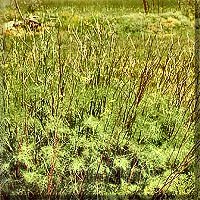

Foeniculum vulgare


Foeniculum vulgare
Plant Characteristics: Erect perennial herb, with anise odor, 1-2 m. high, with striate branching stems, glaucous; lf.-blades ovate to deltoid in outline, to ca. 3 dm. long, pinnately decompound into filiform divisions 4-10 mm. long; petioles broadly sheathing; fls. yellow, in large compound umbels; rays 15-40 +/- unequal, 1-6 cm. long; fr. oblong, 3.5-4 mm. long, the ribs acute; oil tubes solitary in the intervals.
Description - Sweet Fennel was spread on the floors to give a pleasant scent when bruised by the feet. Ancient Egyptians, Hindus and Chinese used fennel seeds for spices. The Romans, then as now cultivated it for its seeds and edible shoots. The fragrant fronds were made into garlands with which to crown victorious warriors. The young stems before they flower, when still tender, are cooked like celery, much of the anise flavor being dissipated in the cooking. Tea can be made by steeping Fennel leaves in hot water. Fennel flowers and leaves together make a yellow dye.
Edible Uses - Condiment; Leaves; Root; Seed; Stem.
A herb tea can be made from the seeds or the leaves.
Medicinal Uses - Analgesic; Antiinflammatory; Antispasmodic; Aromatic; Carminative; Diuretic; Emmenagogue; Expectorant; Galactogogue; Hallucinogenic; Stimulant; Stomachic.
The major constituents, which include the terpenoid anethole, are found in the volatile oil. Anethole and other terpenoids inhibit spasms in smooth muscles, such as those in the intestinal tract, and this is thought to contribute to fennel's use as a carminative (gas-relieving and gastrointestinal tract cramp-relieving agent). Related compounds to anethole may have mild estrogenic actions, although this has not been proven in humans. Fennel is also thought to possess diuretic (increase in urine production), choleretic (increase in production of bile), pain-reducing, fever-reducing, and anti-microbial actions. Fennel was formerly an official drug in the United States and was listed as being used for indigestion.
Other Uses - Dye; Essential; Repellent; Strewing.
The seed yields up to 5% of an essential oil. This is used medicinally, as a food flavouring, in toothpastes, soaps, perfumery, air fresheners etc. The flavour of fennel oil depends upon its two main constituents:
The proportions of these two ingredients varies according to strain and region. Plants growing in the Mediterranean and southern Europe usually have a sweet oil whilst plants growing in central and northern Europe usually produce a more bitter oil. The quality of the oil also depends upon how well the seed has been dried - the oil from fully ripened and dried seeds being much sweeter and more fragrant. It's other uses are:
Pharmacology - A large number of constituents have been identified in fennel, but its desirable stomachic and carminative properties are attributed primarily to the volatile oil that exists in the fruits to the extent of about 2 to 6 percent. This oil consists mostly (50 to 90 percent) of trans-anethole, with smaller amounts of fenchone (up to 20 percent), estragole, limonene, camphene, and a-pinene. Producing essentially the same actions as the fruit, the oil has been shown to exert spasmolytic (relieves spasms) effects on smooth muscles of experimental animals. This may partially explain fennel's effectiveness as a carminative.
Dosages - Whole seeds may be chewed or used in tea. To make a tea, boil 1/2 teaspoon of crushed seeds in 250 ml (1 cup) of water for ten to fifteen minutes, keeping the pot covered during the process. Cool, strain, and then drink three cups per day; As a tincture, 2-4 ml can be taken three times per day.
Seeds:
Root - Decoction prescribed for urinary problems, such as kidney stones, or disorders associated with high uric acid content.
Contr-indications - No significant adverse effects have been reported. However, in rare cases fennel can cause:
Anyone with an estrogen-dependent cancer (e.g., some breast cancer patients) should avoid fennel in large quantities until the significance of its estrogen-like activity is clarified.